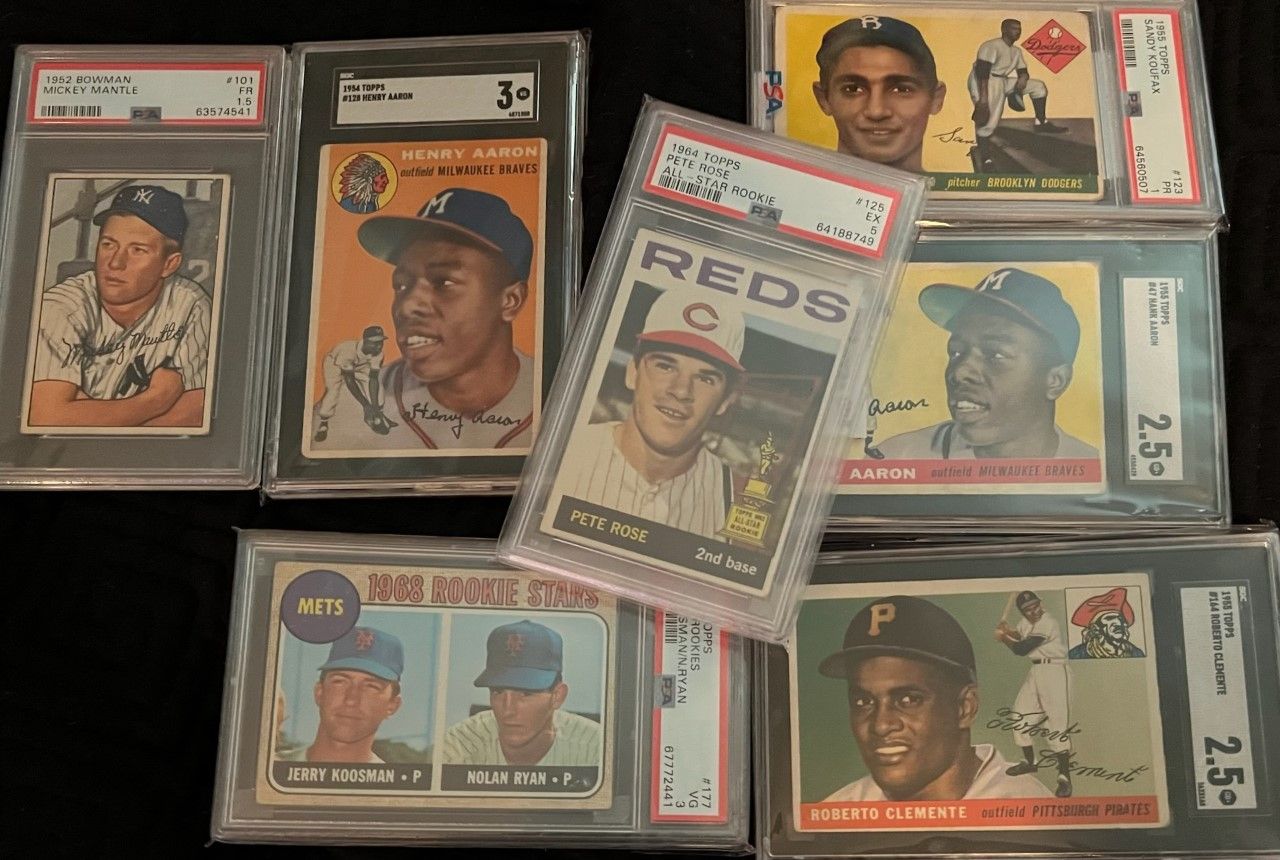
Beyond Vintage Rookies: Second-Year Cards Rule!
Summary
Vintage rookies of Clemente, Aaron, Mantle, Mays, Musial, Rose, Ryan, and Koufax can break the bank. Their second year cards are far more affordable, and they often have close to the same stats and populations for 10% to 20% of the cost!
Some vintage sports card collectors focus solely on iconic cards and the so-called “Grail” cards that they have always wanted to own. These often tend to be the prized rookie cards of super-stars and Hall of Fame players. The reality is that chasing rookie cards can break your bank account by paying thousands of dollars for a card that might not even be in good condition. One way to avoid the financial panic while still owning a great vintage card is to buy second year cards of these great players.
This comes with an admission that the same analogy can be said of other subsequent years of these HOF players. Fifth-year cards generally are not worth what second-year cards are worth, and 1970s cards of the same player are not generally worth what their sixties cards are worth — again, generally, and of course there are exceptions. So do not go out and try buying all of a player’s subsequent cards thinking you are beating the rookie card game. Still, the raw math behind the data should raise some eyebrows when the economy is forcing many people to care more about their finances than they have had to in recent years.
One harsh reality is that the scarcity behind rookie vintage cards in the supply and demand balance is that the cards are frequently not all that scarce. What they do have going for them is high demand. Some second-year cards of these great players may have very similar population stats compared to the rookie card, but they may also have much larger ungraded populations as a “phantom population.”
These second-year cards are easily affordable on a relative basis for vintage collectors at the same or lower grades — often one-fifth to one-tenth of the cost.
Starting with the 1940s to 1960s players, it is well known that the Hall of Fame rookie cards have become unattainable to most vintage card collectors. Even low-grade examples can cost thousands of dollars. Jackie Robinson, Mickey Mantle, Willie Mays, Eddie Mathews, Hank Aaron, Roberto Clemente and Sandy Koufax are just some of the great names that come to mind.
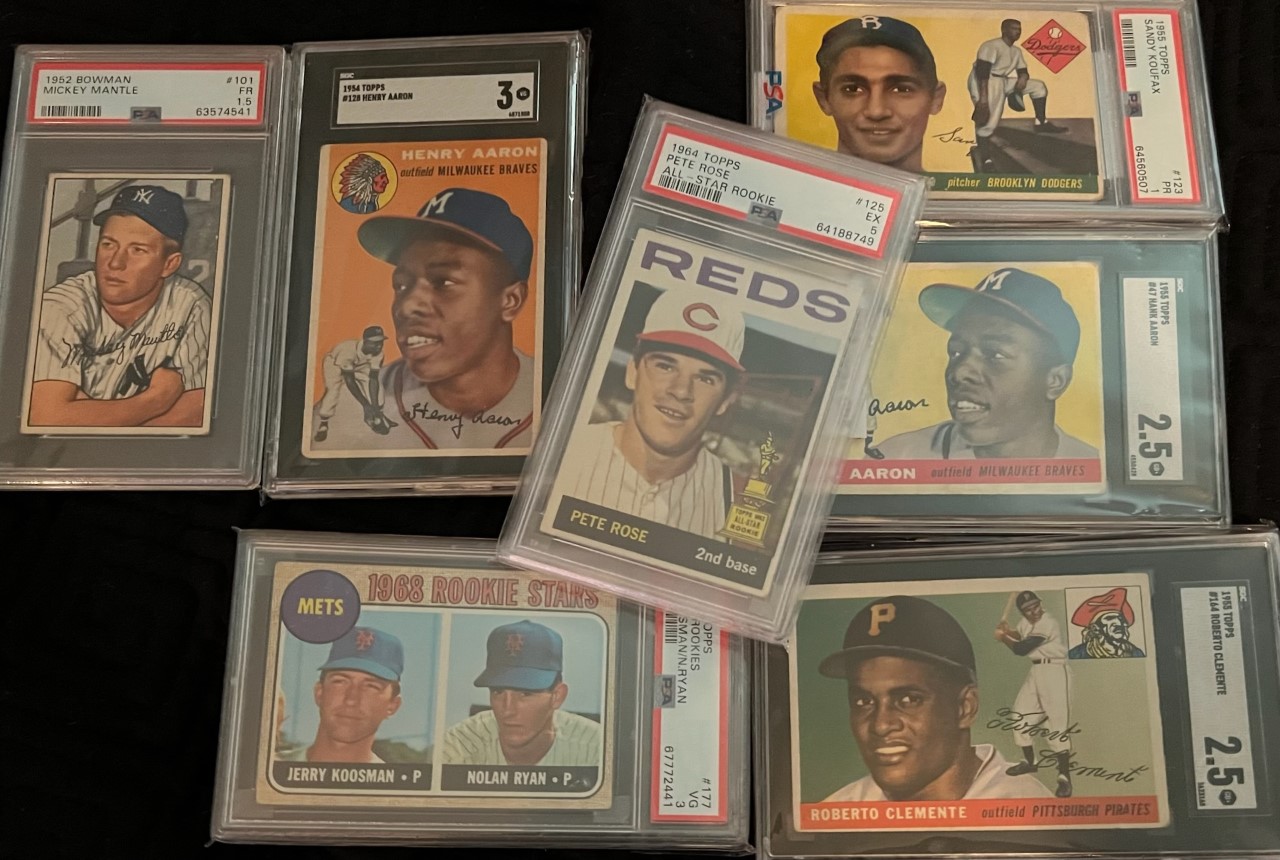
Without placing these cards in any order, here is a quick look at second year vintage Hall of Fame baseball cards that do not have to be destructive to collectors’ hard-earned savings. For simplicity purposes and for time management purposes, it is just assumed that you know about the great careers of these players.
Due to such high prices and due to both players being present for the 1951 Bowman, the 1952 Bowman and 1952 Topps, Willie Mays and Mickey Mantle have not been given the same reviews here. This review has also excluded rare issuers and other variations from the top card sellers of the 1950s and 1960s.
PETE ROSE
The 1963 Topps Pete Rose card (#537) is not all-that visually pleasant to look at. The 4-in-1 photo including Pedro Gonzales, Ken McMullen and Al Weis has circular photos so small you can hardly even get a feel for the fact that Pete was going to grow up into one of the greatest players that ever set foot on a baseball diamond. The graded populations on last look were as follows: PSA 5,885; SGC 1,571; and BVG 918 – nearly 8,400 graded examples combined.
The 1964 Topps Pete Rose card (#125) still points to the All-Star Rookie emblem on the front of the card. The facial photo is “All Pete” and the back of the card shows he played in 157 games with .273 average and an impressive 170 hits. The PSA population of 6,249 graded examples is hardly any larger than the 5,885 examples of his prized and very ugly rookie card. And unlike a cost of $1,000 or more in SGC 2 and PSA 2 examples, the 1964 Topps Pete Rose doesn’t even cost $1,000 until yet get into PSA 7 and SGC 7 examples. In fact, as of April 2023, PSA and SGC 5 grades were still found for under $500 in recent sales.
EDDIE MATHEWS
Eddie Mathews is an undervalued player on his own after being Hank Aaron’s co-star for the Braves for many years and boasting more than 500 homers all on his own. The 12-time all-star for 17 seasons is generally one of the most sought after cards in the 1952 Topps set. His rookie card is the last card (#407) in the set, it is generally subject to atrocious centering, it is often riddled with rounded corners, edge wear from rubber bands and many other issues which damage the card. And good luck buying a card in PSA or SGC “1” for less than $2,000 to $3,000. A solid mid-grade example will cost close to $10,000 now, and the populations of 237 for SGC and 902 for PSA leave very few copies to be acquired by “Grail” chasers.
The 1953 Topps Eddie Mathews card (#37) is an attractive painted portrait of the young great player. PSA’s graded population counts more than 2,000 examples, and 545 have been graded by SGC. Both PSA and SGC 3 graded examples do not even cost $200.00 at the present time. That may be because the 1960s cards of Ed Mathews are given no respect compared to the Mantle, Mays, Aaron, Clemente cards. Either way, this is a dirt cheap way to buy into early Ed Mathews cards. Don’t even bother wondering how inexpensive the cards are for 1954 because it is baffling. There is also the color photo card of Mathews from the 1953 Bowman set that many collectors love.
NOLAN RYAN
The all-time strike-out king’s 1968 Topps card is not all that attractive visually, being shared with Jerry Koosman. It’s also really not a scarce card at all. For scarcity, the last data showed more than 14,700 examples graded by PSA alone, and SGC’s population of 4,130 and BVG’s population of 3,769 make up about 22,600 graded examples. Even the autographed examples are quite plentiful. Because these cards are so plentiful, vintage “Grail Hunters” can still buy a rookie Nolan Ryan in a PSA 3 and 4 for under $1,000 without being the biggest sticklers about centering or corner wear.
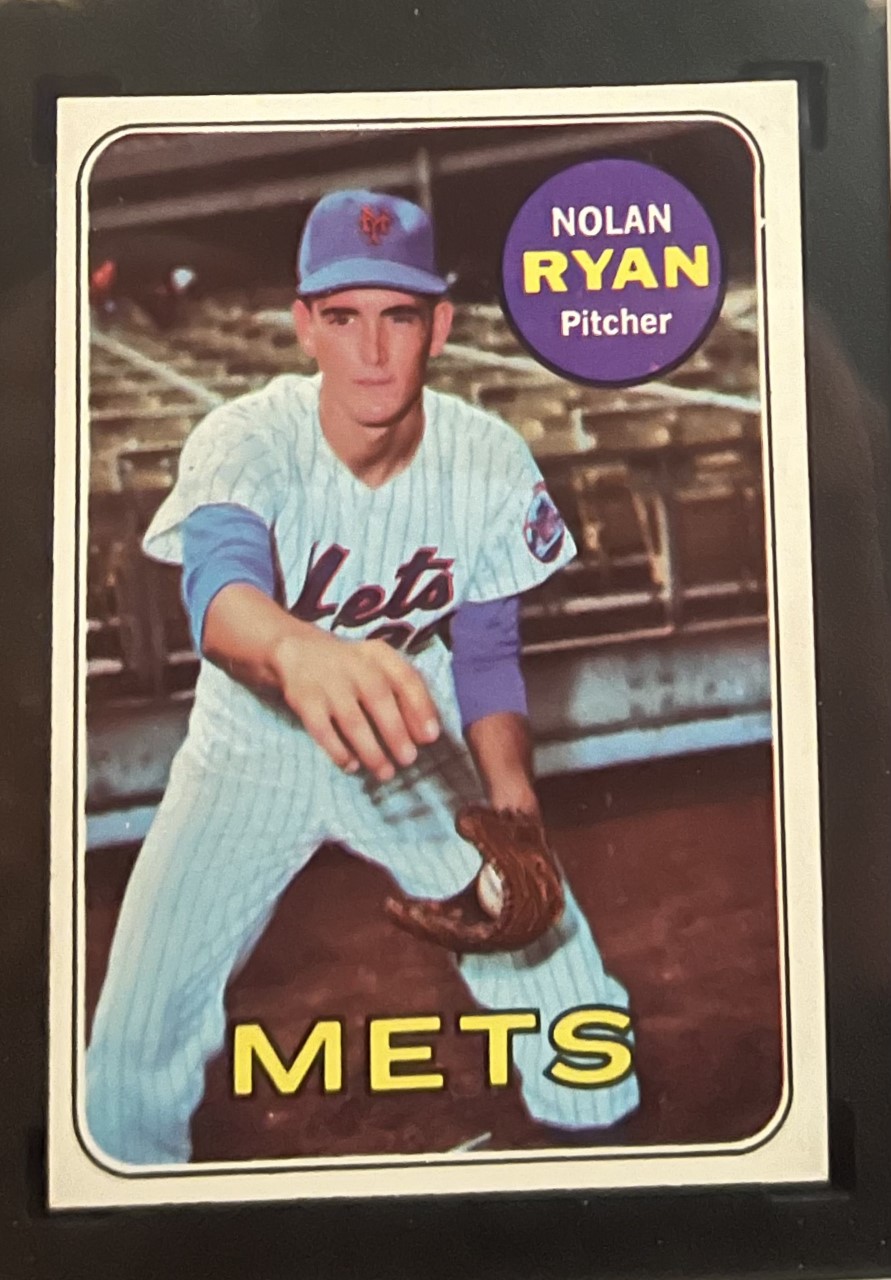
The 1969 Topps Nolan Ryan card (#533) is all dedicated to an obviously faked pitching pose. PSA also still has nearly 8,000 graded examples of the 1969 Topps Nolan Ryan, and SGC still has almost 1,750 graded examples. The difference here is that, outside of persistent centering issues, the 1969 Topps Nolan Ryan can be quite stunning and crisp visually when compared to the beige rookie card. PSA 5 and 6 graded examples are not even $500 at the present time and the last five of the PSA 7 sales were all well under $1,000.
STAN MUSIAL
The real rookie card of Stan ‘The Man’ Musial may be the 1946 Propogandas, but most collectors will never see one and if they could they couldn’t touch it without a rich uncle giving them cash. Even the 1948 Bowman and 1948 Leaf cards can run into the thousands of dollars without getting into PSA and SGC 1 grades. SGC has 411 graded cards of the 1948/49 Leaf and 848 graded examples of the 1948 Bowman. PSA graded examples number more than 1,150 of the 1948-49 Leaf Musial cards, and PSA has more than 2,100 graded examples of the black and white “Bowman rookie” card that looks more like a police mugshot. These cards are also hard to secure for under $1,000 unless the boys had mangled the cards.
Stan Musial’s 1949 Bowman (#24) is not much better visually than the 1948 Bowman, but at least it has a navy background and he is batting. PSA has barely 1,130 graded examples and there are just 400 graded by SGC. The difference here is that collectors can buy PSA 5 and SGC 6 examples for under $1,000. And more affordable examples of PSA 3 and SGC 3 are still under $500 each.
One of the most visually attractive Musial cards is the 1952 Bowman, and outside of the Berk Ross cards it is really one of a handful of 1950’s Musial cards until the 1958 Topps All-Star and regular 1959 Topps Musial cards. These cards are also much more affordable, attractive and available by comparison to any of the 1948 and 1949 cards.
SANDY KOUFAX
The 1955 Topps rookie card of Sandy Koufax is a true iconic card of one of the greatest fastball pitchers that is still alive today. His numbers might have looked even greater had it not been for throwing his arm out prematurely, along with the reputation for a fastball that was so fast it would rise. One additional factoid about the 1955 Topps “rookie card” is that by some measures it should be a pre-rookie card because the stats on the back simply say “NOT IN ORGANIZED BASEBALL” and show a notation of a large signing bonus and lots of strike outs for University of Cincinnati. Due to such large graded populations (10,034 from PSA; 2,846 from SGC; and 1,349 from BVG – or more than 14,200 graded examples combined), PSA 3 and SGC 3 graded examples of the 1955 Topps Koufax can still be purchased for under $1,000.
The 1956 Topps card of Sandy Koufax (#79) comes in the gray back and white back variation. As these gray and white backs were not tracked separately for so many years, it is impossible to know the true numbers of which variation’s numbers are more realistic versus the other. SGC has the graded populations for Koufax’s gray back as 894 examples and 981 white back examples. PSA’s population reports show gray back as 1,818 examples and 4,873 white back examples. In the first four months of 2023, the PSA 5 examples and SGC 5 were still selling for close to $400.00 on average.
ROBERTO CLEMENTE
Roberto Clemente’s legend in sports has not faded at all in time. In fact, his legend only seems to have improved among vintage card collectors. Clemente’s cards are also at a premium to almost all other players in each set other than the Mantle, Mays, Aaron trio. The green background for the 1955 Topps Clemente card jumps out at collectors when the colors are not faded and when there is no paper loss. The biggest sin facing the Clemente rookie’s eye appeal is that the centering is rarely good by any measurement. Still, this is an iconic card that is a Grail to most collectors and its price is at significant premium to Koufax’s same year rookie card. Koufax’s card is much more easy to find, although the Clemente graded numbers are high enough that the card is no longer considered to be scarce for vintage buyers even if the price remains high.
Here are the grading stats for the 1955 Clente card: PSA lists 6,537 graded examples and SGC counts 1,980 graded examples, and BVG has another 836 examples – for 9,353 graded examples from the big three graders. Even PSA and SGC “1” grades are common to see in a $1,000 to $1,500 price range. PSA and SGC “2” will often range from $1,400 to $2,000 depending on their eye appeal, and those graded as “3” can sell for $1,800 to $2,400 when averaged out.
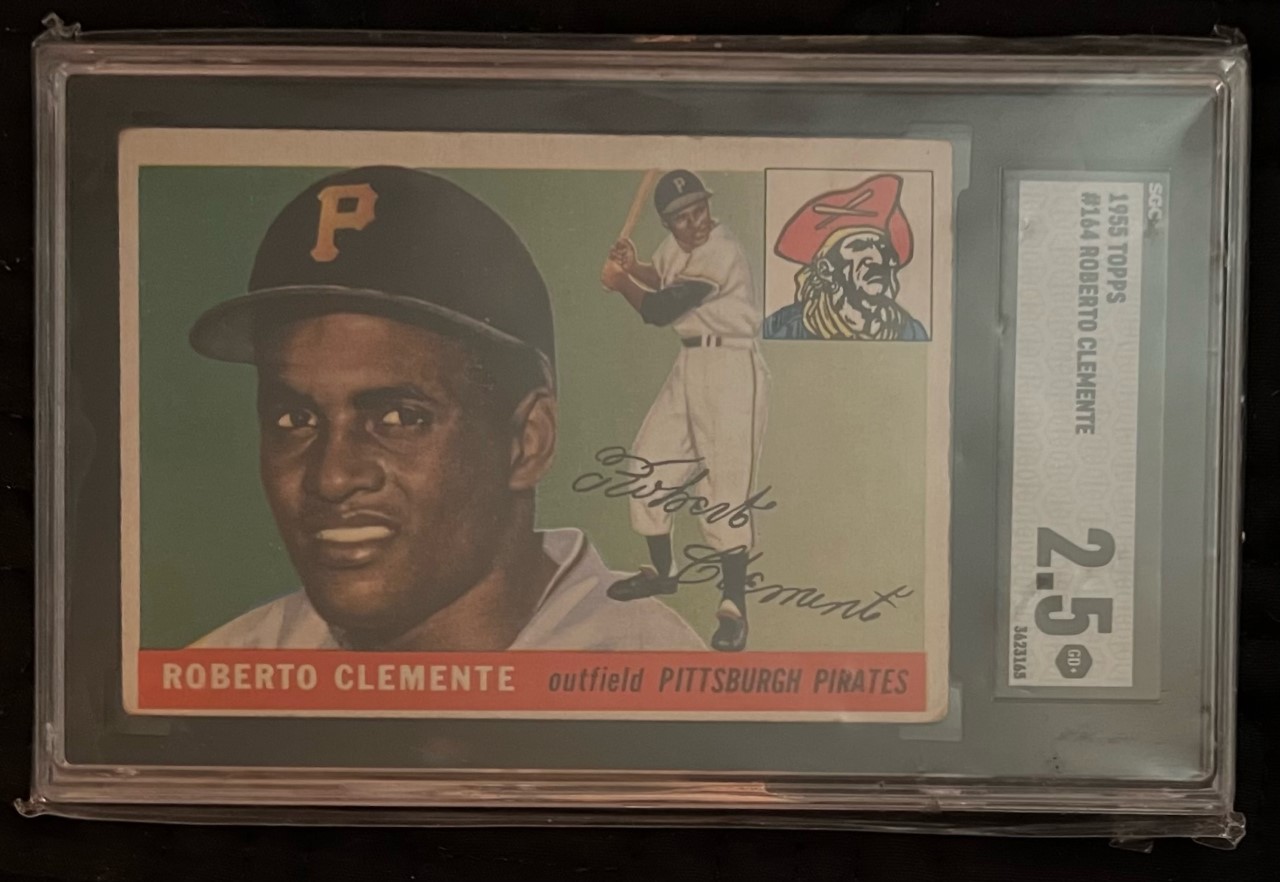
The 1956 Topps Clemente (#33) has the same portrait image as the 1955 Topps, but Clemente is making a leaping outfielder catch with the wall in the background rather than in a generic batting pose on the green painted backdrop. As a lower-number card in the 1956 Topps set this card also comes in a gray back and white back variation. PSA shows the white backs being much more common with 5,069 examples versus 2,016 gray back variations. As with others, we simply do not know the real counts because back colors were not always registered. SGC counts 1,062 gray back and 1,183 white back examples; and BVG lists 272 gray back and 675 regular graded examples. That’s 10,277 gray and white back graded examples from the top 3 graders, or less than 1,000 (only 9.9% more).
Where Clemente’s 1956 Topps card shines versus the rookie is on the relative affordability. PSA 1 and 2 grades can sell for under $200 for a “1” to a range of $275 to $300 for a “2.” Buyers can get up into PSA and SGC grades of 5 to 6 before the $1,000 card prices generally comes into play. Having the second year card here is by no means owning the rookie card, but Clemente is yet another example of how similar cards can have night and day pricing discrepancies.
HANK AARON
The 1954 Topps card (#128) Hank Aaron rookie card is without much argument the most iconic card reviewed here in this article, and was saved for last. The card’s print quality often comes with rough edges and its left-right centering can sometimes be atrocious. That said, it is a true Grail for most collectors as Babe Ruth cards in any condition from his playing years can break the bank. The graded population of Aaron’s cards is actually not all that scarce (PSA has 6,523 examples; SGC has 1,939 examples; and BVG has 906 examples – or 9,368 graded examples of all three grading leaders).
So, how much do rookie Hank Aaron cards cost in 2023? Most PSA 1 graded examples are still under $2,000 today, with PSA 2 sales ranging from about $2100 to $2800 and PSA 3 generally in a $3,000 to $3,750 range.
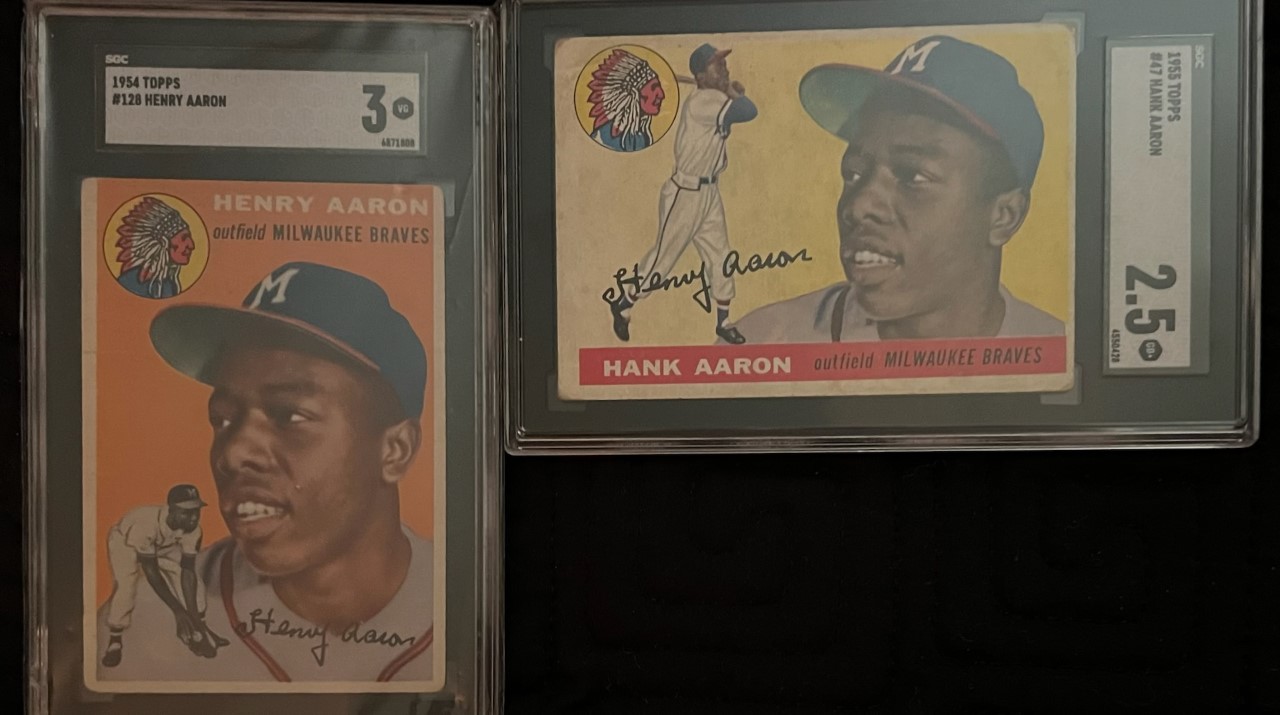
The 1955 Topps Hank Aaron (#47) comes with bright yellow presentation showing Aaron in a full swing and in a portrait. Its graded population is nearly identical to the 1954 Topps rookie. Its graded population is almost identical to the rookie issue. PSA counts 6,333 graded examples; with 2,100 from SGC; and 894 from BVG — for 9,327 graded examples from the top 3 grading companies. Many sales in both SGC % and PSA 5 have still been under $1,000 in 2023 for Aaron’s second-year card with Topps.
Another “second year” play for Hank Aaron is the 1955 Bowman issue, although due to it being Bowman’s last year and due to many collectors having mixed emotions about the brown wood-grain TV appearance this card is up to you to review.
*******
Comparing second year card prices to rookie card prices is not a new exercise, not in vintage and not in modern cards. It should not be a shock that the card prices are so much higher for rookie cards either. It also probably shouldn’t be a huge surprise that the graded populations can be smaller or similar for a second year card because everyone knows to grade a rookie of these vintage players named above regardless of the condition. With all that said, this just shows how much more card can be purchased per dollar looking at second-year versus rookie year cards for budget minded vintage collectors.
This may also beg a question. Are rookie cards worth the premium to subsequent year cards? That answer is simply one which can only be known by each collector and how they view and value their “Grail” cards. Either way, paying 10% to 20% of a rookie card price for what may be relatively the same population and a much wider audience that can afford them has to have at least some merit for collectors.
And by the way, if you have vintage rookie and subsequent HOF player cards you want to sell or have consigned then please CONTACT US! by phone or email.
Eddie Mathews, Hank Aaron, Jackie Robinson, Mickey Mantle, Nolan Ryan, Pete Rose, Roberto Clemente, Willie Mays
